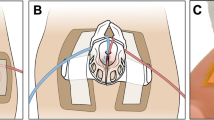Abstract
OBJECTIVES: To compare the predictive value of pH, base deficit and lactate for the occurrence of moderate-to-severe hypoxic ischaemic encephalopathy (HIE) and systemic complications of asphyxia in term infants with intrapartum asphyxia.
STUDY DESIGN: We retrospectively reviewed the records of 61 full-term neonates (≥37 weeks gestation) suspected of having suffered from a significant degree of intrapartum asphyxia from a period of January 1997 to December 2001.
The clinical signs of HIE, if any, were categorized using Sarnat and Sarnat classification as mild (stage 1), moderate (stage 2) or severe (stage 3). Base deficit, pH and plasma lactate levels were measured from indwelling arterial catheters within 1 hour after birth and thereafter alongwith every blood gas measurement. The results were correlated with the subsequent presence or absence of moderate-to-severe HIE by computing receiver operating characteristic curves.
RESULTS: The initial lactate levels were significantly higher (p=0.001) in neonates with moderate-to-severe HIE (mean±SD=11.09±4.6) as compared to those with mild or no HIE (mean±SD=7.1±4.7). Also, the lactate levels took longer to normalize in these babies. A plasma lactate concentration >7.5±mmol/l was associated with moderate-or-severe HIE with a sensitivity of 94% and specificity of 67%. The sensitivity and negative predictive value of lactate was greater than that of the pH or base deficit.
CONCLUSIONS: The highest recorded lactate level in the first hour of life and serial measurements of lactate are important predictors of moderate-to-severe HIE.
This is a preview of subscription content, access via your institution
Access options
Subscribe to this journal
Receive 12 print issues and online access
$259.00 per year
only $21.58 per issue
Buy this article
- Purchase on Springer Link
- Instant access to full article PDF
Prices may be subject to local taxes which are calculated during checkout

Similar content being viewed by others
References
Silva SD, Hennebert N, Denis R, Wayenberg JL . Clinical value of single postnatal lactate measurement after intrapartum asphyxia. Acta Paediatr 2000;89:320–323.
Deshpande SA, Ward Platt MP . Association between blood lactate and acid base status and mortality in ventilated babies. Arch Dis Child Fetal Neonatal Ed 1997;76:F15–F20.
Cady Jr LD, Weil MH, Afifi AA, Michales SF, Liu VY, Shubin H . Quantitation of severity of critical illness with special reference to blood lactate. Crit Care Med 1973;1:75–80.
Kruse JA, Zaidi AS, Carlson RW . Significance of blood lactate levels in critically ill patients with liver disease. Am J Med 1987;83:77–82.
Cheung PY, Robertson CMT, Finer NN . Plasma lactate as a predictor of early childhood neurodevelopmental outcome of neonates with severe hypoxemia requiring extra corporeal membrane oxygenation. Arch Dis Child Fetal Neonatal Ed 1996;74:F47–F50.
Low JA, Panagiotopoulos C, Derrick EJ . Newborn complications after intrapartum asphyxia with metabolic acidosis in the term foetus. Am J Obstet Gynecol 1994;170:1081–1087.
King TA, Jackson GL, Josey AS, et al. The effect of profound umbilical artery acidemia in term neonates admitted to newborn nursery. J Pediatr 1998;132:624–629.
Vannucci RC, Perlman JM . Interventions for perinatal hypoxic ischemic encephalopathy. Pediatrics 1997;100:1004–1014.
Cheung PY, Robertson CMT . Predicting the outcome of term neonates with intrapartum asphyxia. Acta Paediatr 2000;89:262–271.
Sarnat HB, Sarnat MS . Neonatal encephalopathy following fetal distress. A clinical and electroencephalographic study. Arch Neurol 1976;33:696–705.
Hatherill M, Mcintyre AG, Wattie M, Murdoch A . Early hyperlactatemia in critically ill children. Intensive Care Med 2000;26:314–318.
Duke TD, Butt W, South M . Predictors of mortality and multiple organ failure in children with sepsis. Intensive Care Med 1997;23:684–692.
Beca JP, Scopes JW . Serial determinations of blood lactate in respiratory distress syndrome. Arch Dis Child 1972;47:550–557.
Charpie J, Dekeaon M, Goldberg C, Mosca R, Bove E, Kulik T . Serial blood lactate measurements predict early outcome after neonatal repair or palliation for complex congenital heart disease. J Thorac Cardiovasc Surg 2000;120:73–80.
Grayck EN, Meliones JN, Kern F, et al. Elevated serum lactate correlates with intracranial hemorrhage in neonates treated with extracorporeal life support. Pediatrics 1995;96:914–918.
Cheung P, Finer N . Plasma lactate as a predictor of death in neonates with severe hypoxemia requiring extracorporeal membrane oxygenation. J Pediatr 1994;125:763–768.
Frey B, Pfenninger J, Bachmann D . Reply. J Pediatr 1995;127:334.
Huang C, Wang S, Chang Y, Lin K, Wu P . Measurement of urinary lactate:creatinine ratio for early identification of newborn infants at risk for hypoxic ischaemic encephalopathy. N Engl J Med 1999;341:328–335.
Hawdson JM, Ward Platt, Aynsley-Green A . Patterns of metabolic adaptation for preterm and term infants in the first neonatal week. Arch Dis Child 1992;67:357–365.
Winkler CL, Hautch JC, Tucker JM, Owen J, Brumfield CG . Neonatal complications at term as related to the degree of umbilical artery acidemia. Am J Obstet Gynecol 1991;164:637–641.
Author information
Authors and Affiliations
Rights and permissions
About this article
Cite this article
Shah, S., Tracy, M. & Smyth, J. Postnatal Lactate as an Early Predictor of Short-Term Outcome after Intrapartum Asphyxia. J Perinatol 24, 16–20 (2004). https://doi.org/10.1038/sj.jp.7211023
Published:
Issue Date:
DOI: https://doi.org/10.1038/sj.jp.7211023
This article is cited by
-
Risk factors for unfavorable outcome at discharge of newborns with hypoxic-ischemic encephalopathy in the era of hypothermia
Pediatric Research (2023)
-
Arterial pressure is not reflective of right ventricular function in neonates with hypoxic ischemic encephalopathy treated with therapeutic hypothermia
Journal of Perinatology (2023)
-
Serum troponin I: a potential biomarker of hypoxic-ischemic encephalopathy in term newborns
Child's Nervous System (2022)
-
Theoretical basis for the use of non-invasive thermal measurements to assess the brain injury in newborns undergoing therapeutic hypothermia
Scientific Reports (2020)
-
Nucleated red blood cells and serum lactate values on days 2 and 5 are associated with mortality and morbidity in VLBW infants
Wiener Medizinische Wochenschrift (2019)



